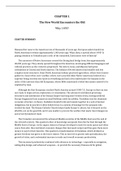CHAPTER 1
The New World Encounters the Old
Why 1492?
CHAPTER SUMMARY
Humans first came to the Americas tens of thousands of years ago. European sailors landed on North American territory approximately 1,000 years ago. What, then, is special about 1492? Is paying attention to Columbus just a relic of the outmoded, Eurocentric view of history?
The ancestors of Native Americans crossed the Bering land bridge from Asia approximately 40,000 years ago. They slowly spread throughout the Americas, developing different languages and cultural practices as the centuries progressed. The Aztecs, Incas, and Mayans built great civilizations in Central and South America. The Indians of North America had smaller and less complex social structures. Some North American Indians practiced agriculture; others were hunter-
gatherers. Some tribes were warlike; others were peaceful. Most Native Americans believed in a supreme being, but they saw spirit in everything and had a less exalted place for humans in the order of the universe than did Europeans, whose Bible sanctioned a belief that nature existed to be exploited by man.
Although the first Europeans reached North America around 1000 C.E., Europe in that era was not ready to begin serious exploration or colonization. The advanced centralized governing structures and institutions of the Roman Empire had long since broken down, leaving medieval Europe fragmented into numerous small fiefdoms ruled by nobility. Feudalism was the dominant economic structure; in theory, feudalism bonded lords and vassals together in a web of mutual obligations, but in practice it often boiled down to a system of bondage for the peasants who worked the land. The Roman Catholic Church helped unify Europe’s culture, but it focused on the afterlife, not on the good life, and it was unable to prevent the warfare that made travel dangerous and severely hindered trade.
The Crusaders encountered the advanced Muslim societies of the Middle East near the end of the eleventh century. This sparked a flow of knowledge and goods from the Far East through the Middle East to Europe. As the upper classes in Europe developed a taste for exotic spices and other wares from afar, they instituted economic changes that increased output and thus gave them more money to pay for their luxuries. This sparked a transformation of feudalism, which declined as greater freedom was given to the lower classes. This in turn led to greater task specialization, the growth of cities, and a substantial increase in trade and overall economic productivity.
This increased productivity combined with advances in technology—especially in navigation, sailing ship design, and advanced weapons—to provide the necessary framework for global expansion. The Portuguese led the way in exploring the seas, but Spain jumped into the game in 1492 when it financed Columbus’ expedition. The Genoans made several voyages, laying the groundwork for later Spanish explorations and the coming of the conquistadors. These conquerors quickly subjugated the indigenous peoples and instituted brutal rule over their new subjects in Central and South America and the Caribbean. Eventually other European countries sought to emulate Spain’s achievements. England, France, the Netherlands, and Portugal all staked out territory in the Americas.
The Columbian exchange facilitated movement of plants, products, diseases and social structures between the Americas and Europe. The Europeans got by far the better end of the deal: gold, silver, and numerous new agricultural products entered the Old World’s economy. The indigenous Americans received slavery, exploitation, cultural destruction, and massive death tolls from European diseases to which they had no immunity. CHAPTER OUTLINE
A.The Native Americans
1.The Great Indian Civilizations
2.The Indians of North America
B.The First European “Discovery”
C.The Rise of Modern Europe
1.Medieval Europe
2.The Lure of the East
3.The Nation-State
4.Revolutions in Thought and Communication
5.New Technology D.European Expansion
1.Columbus and the Spanish Explorations
2.Spain Encounters the Indian Civilizations
3.Spain’s Rivals
E.The Columbian Exchange
1.Europe Benefits
F.Conclusions
LEARNING OBJECTIVES
1.Give the date of arrival, origins, and migration patterns of the first Americans.
2.Describe the important characteristics of the Aztec, Incan, and Mayan civilizations.
3.Discuss the cultural, linguistic, religious, and food-gathering characteristics of the North American tribes.
4.Present the main components of Native American religion and show how it differed from that of
Judeo-Christianity.
5.Discuss the early Norse attempts to reach and colonize North America.
6.Present the major social, political, economic, and religious characteristics of medieval Europe. 7.Describe Europe’s contact with the East and how this contact substantially changed the dominant social, political, and economic structures of Europe.
8.Discuss the rise of the European nation-state and its social, political, and economic characteristics.
9.Give the basic premises of Renaissance thought and discuss how the Renaissance affected Europe.
10.Describe the technological innovations that facilitated European colonization of the Americas.
11.Trace the exploration activities of the Portuguese in the fifteenth and sixteenth centuries and describe the nature and extent of Portugal’s power in 1550.
12.Discuss the voyages of Christopher Columbus and identify where he traveled.
13.Summarize the other European voyages of exploration (sea voyages and exploration of the Americas).
14.Describe Spain’s destruction of the Indian empires in Central and South America.
15.Identify the major components of the Columbian Exchange and explain how it affected both Europe and the Americas.




